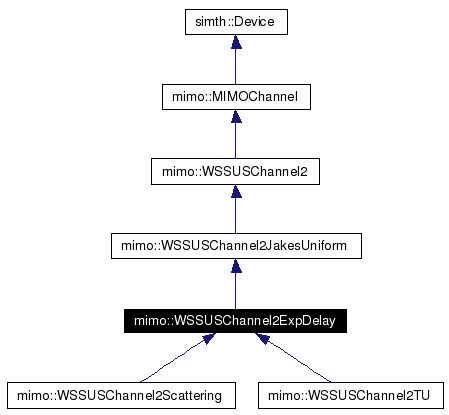|
|
These are the properties of class WSSUSChannel2ExpDelay . This list is auto-generated from the XML-Devicelist of this device by means of an XSLT transformation script.
Description of this device in the XML file:
Note that this class also has the Properties of its base classes. The direct base class is mimo::WSSUSChannel2JakesUniform ; direct link to its propertylist should be propertylist_WSSUSChannel2JakesUniform(). The list below usually includes the properties that have been inherited from the base classes; the properties which belong only to this class can be found at the end of this list.
snr <string>, default "" -- The name of the snr loop variable in this simulation.
channel_refresh <string>, default "" -- The name of the refresh loop variable in this simulation.
nr_tx <unsigned>, default "" -- The number of transmit antennas
nr_rx <unsigned>, default "" -- The number of receive antennas
diagonal <bool>, default "false" -- If true, then this channel has a diagonal channel matrix i.e. it is not a MIMO channel. However, it is unclear whether the SNR is correct or whether the SNR might be offset by the matrix size. This property is probably only useful for initial testing of mimo algorithms.
5 properties in this class. The above properties have been inherited from the base class mimo::MIMOChannel .
num_path <unsigned>, default "30" -- Old WSSUS2 parameter for backward compatibility: The minimum number of scattering paths in the WSSUS2 channel model, which might be ignored anyway. In this WSSUS-MIMO model, the *actual* total number of scattering paths is calculated by L_T*L_R*K (see below). If the actual number L_T*L_R*K is smaller than this value, then K is increased until the product is large enough. If the actual number L_T*L_R*K is larger than this property, then it is ignored.
num_tx_scatterers <unsigned>, default "" -- Important MIMO parameter in WSSUS2 model: Number of distinct transmission angles. In the accompanying research paper, this number is called L_T.
num_rx_scatterers <unsigned>, default "" -- Important MIMO parameter in WSSUS2 model: Number of distinct receiver angles. In the accompanying research paper, this number is called L_R.
paths_per_scatterers <unsigned>, default "" -- Important MIMO parameter in WSSUS2 model: Number of paths between two different scatterers. In the accompanying research paper, this number is called K. This number should be chosen so that the product L_T*L_R*K is 30 or greater. If you choose this number smaller, you should consider setting the property path_ampl_random to true.
array_geometry_rx <enum>, default "linear" -- Geometry of the receiver antenna array
array_geometry_tx <enum>, default "linear" -- Geometry of the transmitter antenna array
path_ampl_random <bool>, default "false" -- If true, then the amplitudes of the paths are random according to a Rayleigh distribution. Otherwise they are fixed (unity).
rice_factor_db <double>, default "-1e6" -- The rice factor of this channel in dB. If unset (minus infinity), then there is no line of sight. The dB property overrides the scalar one.
rice_factor <double>, default "0.0" -- The rice factor of this channel as a scalar. If unset (zero), then there is no line of sight.
normalization_mode <enum>, default "standard" -- The normalization mode in this channel: standard, time, or freq. Additionally the channel will be normalized by the number of transmit antennas.
normalization_duration <unsigned>, default "0" -- Only for normalization mode 'time' or 'frequency': If this is greater than one, then for normalization calculate the norm over several timesteps (= OFDM symbols) instead of the whole duration of the simulation. For a time-variant channel, this will result in some kind of time-variant normalization. Usually this is unused (and for time-invariant channels it doesnt make a difference anyway), but in highly time-variant channels you have to think about your normalization much more carefully.
freq_dist <double>, default "312500" -- Only for normalization mode 'frequency': Distance of frequence samples when calculating the normalization factor in frequency normalization mode
num_freqs <unsigned>, default "64" -- Only for normalization mode 'frequency': Number of frequency points/samples when calculating the normalization factor in frequency normalization mode
oversampling <unsigned>, default "1" -- Only for calculating the correct delta_t: The oversampling rate used by the IDFT (IFFT)
num_carrier <unsigned>, default "1" -- Only for calculating the correct delta_t: The number of subcarriers where the transfer function is calculated. If this is zero or one, the time-domain transmission will be used instead.
carrier_dist <double>, default "0.0" -- Only for calculating the correct delta_t: The subcarrier distance on which the transfer function is calculated.
antenna_coupling_ampl <double>, default "0.0" -- For MIMO antenna coupling: The amplitude of antenna coupling as a scalar (not in dB). If zero, then this is unused.
coupling_phase_random <bool>, default "false" -- For MIMO antenna coupling: If the antenna_coupling_ampl is greater than zero, then this property determines whether the phases of the coupling coefficients are zero or are random.
18 properties in this class. The above properties have been inherited from the base class mimo::WSSUSChannel2 .
max_doppler <double>, default "" -- Maximum doppler frequency in Hz. This is f_0*v/c_0, i.e. for IEEE802.11a or Hiperlan/2 this means: 1 km/h = 5 Hz
1 properties in this class. The above properties have been inherited from the base class mimo::WSSUSChannel2JakesUniform .
max_signal_delay <double>, default "" -- Maximum delay in s.
delay_mean <double>, default "0.0" -- Mean value of the delay profile
2 properties in this class. |


![\[ f(x) = \left\{ \begin{array}{cl} 0 & \mbox{for } x<0, x>T \\ \frac{\lambda}{1-e^{-\lambda T}} e^{-\lambda x} & \mbox{for }0\le x\le T \end{array} \right. \]](form_57.png)
 1.4.1
1.4.1